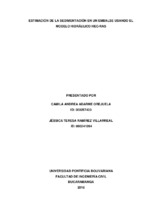| dc.contributor.advisor | Villamizar Amaya, Sandra Rocío | |
| dc.contributor.author | Adarme Orejuela, Camila Andrea | |
| dc.contributor.author | Ramirez Villarreal, Jessica Teresa | |
| dc.coverage.temporal | 2018 | |
| dc.date.accessioned | 2020-06-01T15:06:24Z | |
| dc.date.available | 2020-06-01T15:06:24Z | |
| dc.date.issued | 2018 | |
| dc.identifier.uri | http://hdl.handle.net/20.500.11912/5506 | |
| dc.description | 80 páginas | spa |
| dc.description.abstract | La modelación hidráulica y de transporte de sedimentos puede ser usada para evaluar la vida útil de un embalse y, por consiguiente, apoyar las actividades de planificación del manejo de su cuenca aferente con el propósito de optimizar la operatividad de este. Este documento muestra el trabajo desarrollado en el marco de la modelación hidráulica y de sedimentos del embalse de Bucaramanga (cuenca del río Tona) usando un modelo unidimensional con la herramienta HEC—RAS 5.0.3. El modelo se estructuró a partir de 67 secciones transversales que representan la geometría del área embalsada. La modelación se realizó para escenarios presentes y futuros de caudal y sedimentos en condiciones de flujo cuasi-permanente. Los resultados de la modelación permitieron obtener estimativos de la reducción potencial de la capacidad volumétrica del embalse. Adicionalmente, en el marco del trabajo realizado, se desarrolló un manual que se espera sirva a nuevos usuarios de la herramienta a reducir su curva de aprendizaje. El modelo y sus resultados se podrían beneficiar a futuro por datos de campo que permitan mejorar la parametrización de este y su calibración. | spa |
| dc.description.abstract | Hydraulic and sediment transport modelling can be used to evaluate the lifespan of a reservoir, and its results may be used to support the planification and management practices of its afferent basin in order to optimize its operation. This document shows the work developed in the framework of the hydraulic and sediment modeling of the Bucaramanga reservoir (Tona river basin) using a one-dimensional model with the tool HEC-RAS 5.0.3. The model was structured from 67 cross sections that represent the geometry of the impounded area. The modeling effort was performed for present and future discharge and sediment scenarios under quasi-permanent flow conditions. The results allowed to obtain estimates of the potential reduction of the volumetric capacity of the reservoir. Additionally, a user manual was developed which is expected to help new users of the software to reduce their learning curve. The model and its results could benefit in the future by field data that would improve the model's parameterization and its calibration. | eng |
| dc.format.mimetype | application/pdf | |
| dc.language.iso | spa | |
| dc.publisher | Universidad Pontificia Bolivariana | spa |
| dc.rights | Attribution-NonCommercial-NoDerivatives 4.0 International | * |
| dc.rights.uri | http://creativecommons.org/licenses/by-nc-nd/4.0/ | * |
| dc.title | Estimación de la sedimentación en un embalse usando el modelo hidráulico Hec-ra | spa |
| dc.type | Trabajo de grado | spa |
| dc.publisher.department | Escuela de Ingenierías | spa |
| dc.publisher.program | Ingeniería Civil | spa |
| dc.type.hasVersion | publishedVersion | spa |
| dc.description.sectional | Bucaramanga | spa |
| dc.description.degreename | Ingeniero Civil | spa |


